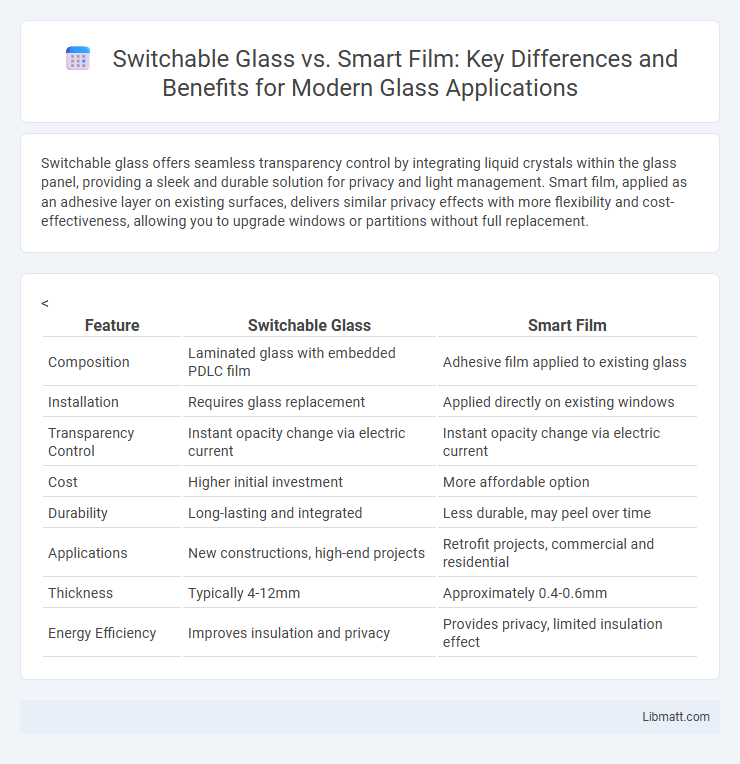Switchable glass offers seamless transparency control by integrating liquid crystals within the glass panel, providing a sleek and durable solution for privacy and light management. Smart film, applied as an adhesive layer on existing surfaces, delivers similar privacy effects with more flexibility and cost-effectiveness, allowing you to upgrade windows or partitions without full replacement.
Table of Comparison
| Feature | Switchable Glass | Smart Film |
|---|---|---|
| Composition | Laminated glass with embedded PDLC film | Adhesive film applied to existing glass |
| Installation | Requires glass replacement | Applied directly on existing windows |
| Transparency Control | Instant opacity change via electric current | Instant opacity change via electric current |
| Cost | Higher initial investment | More affordable option |
| Durability | Long-lasting and integrated | Less durable, may peel over time |
| Applications | New constructions, high-end projects | Retrofit projects, commercial and residential |
| Thickness | Typically 4-12mm | Approximately 0.4-0.6mm |
| Energy Efficiency | Improves insulation and privacy | Provides privacy, limited insulation effect |
Introduction to Switchable Glass and Smart Film
Switchable glass and smart film both utilize electrochromic or polymer-dispersed liquid crystal (PDLC) technology to control light transmission and privacy. Switchable glass integrates this technology directly into the glass pane, providing a seamless, durable, and aesthetically pleasing solution with high optical clarity. Smart film is applied as a retrofit film onto existing windows, offering a cost-effective and flexible option for transforming standard glass into switchable privacy glass without full window replacement.
How Switchable Glass Works
Switchable glass operates by applying an electrical current to liquid crystal or suspended particle layers embedded within the glass, altering its opacity from clear to opaque instantly. This technology allows you to control privacy and light transmission without the need for blinds or curtains. Smart film, on the other hand, is a retrofit solution applied to existing glass, providing similar functionality through an adhesive film that changes transparency when powered.
How Smart Film Operates
Smart film operates by changing its opacity when an electric current passes through it, transforming from opaque to transparent in seconds. This technology involves a layer of liquid crystal molecules sandwiched between two layers of conductive material, which align under voltage to control light transmission. Your choice between switchable glass and smart film depends on installation preferences and flexibility, as smart film can be applied to existing windows.
Key Differences Between Switchable Glass and Smart Film
Switchable glass integrates electrochromic or PDLC technology directly into the glass, enabling seamless transparency control without additional installation, whereas smart film is a retrofit solution applied to existing glass surfaces. Switchable glass offers superior durability and uniform visual clarity, while smart film provides greater flexibility and cost-effectiveness for temporary or customizable applications. Your choice depends on whether you prioritize long-term investment and aesthetics or adaptability and budget constraints.
Installation Process: Switchable Glass vs Smart Film
Switchable glass features a factory-laminated integration process directly embedded between glass panes, requiring professional installation typically during manufacturing or glazing stages. Smart film is a retrofit solution applied on existing glass surfaces, offering simpler and faster installation with adhesive backing that can be cut to size on-site. Both options demand electrical wiring for their opacity control, but smart film's flexibility and ease of installation make it ideal for renovation projects.
Performance and Durability Comparison
Switchable glass offers superior optical clarity and faster transition times between opaque and transparent states compared to smart film, ensuring reliable performance in demanding environments. Smart film, while more flexible and easier to retrofit on existing windows, tends to have shorter durability with potential issues like peeling or reduced opacity over time. You should consider switchable glass for long-term investment in high-performance applications, whereas smart film suits cost-effective, less permanent solutions.
Cost Comparison and ROI Analysis
Switchable glass typically involves higher upfront costs due to its integrated technology and replacement window installation, whereas smart film offers a more cost-effective retrofit solution for existing glass surfaces. Your return on investment (ROI) depends on energy savings, privacy needs, and installation scale, with smart film providing quicker payback in commercial or residential upgrades. Evaluating the total cost of ownership, including maintenance and efficiency gains, is essential to determine the best value for your specific project.
Aesthetic and Design Considerations
Switchable glass offers sleek, seamless integration with modern architecture, providing a crystalline appearance that enhances natural light while maintaining privacy at the flick of a switch. Smart film can be retrofitted onto existing glass surfaces, allowing for versatile design modifications without complete replacement, perfect for preserving historic or cost-sensitive projects. Both technologies support minimalist aesthetics but differ in installation flexibility and surface uniformity, influencing design choices based on project goals.
Typical Applications and Use Cases
Switchable glass is commonly used in high-end office partitions, conference rooms, and luxury residential spaces to provide instant privacy and light control without sacrificing natural light. Smart film finds widespread application in retrofitting existing windows, vehicle windows, and commercial storefronts due to its easy installation and cost-effectiveness. Both technologies are popular in healthcare facilities for patient privacy, educational institutions for flexible learning environments, and retail spaces for dynamic displays.
Choosing the Right Solution: Factors to Consider
When deciding between switchable glass and smart film, consider factors such as installation flexibility, cost efficiency, and durability within your space. Switchable glass offers seamless integration and superior optical clarity but usually requires replacement of existing windows, while smart film can be applied to existing surfaces with lower upfront costs and easier upgrades. Assessing your project's requirements for privacy control, maintenance, and budget will help determine the most suitable solution for your environment.
switchable glass vs smart film Infographic

 libmatt.com
libmatt.com